GARDENING: Caring for your orchids with Brian Kidd


When grown at home, these are far less trouble than other types of orchid. During the spring and summer they are best grown in plenty of light but not in direct sun. The plants must never dry out and rain water is suitable because they don't like the chalk in our water.
In autumn and winter, watering must be done carefully. The compost must never dry out and it's a good idea to spray the compost regularly using rain water to keep it moist. This compost comprises equal parts osmunda fibre and sphagnum moss '“ I grow osmunda ferns in the stream in our garden.
Advertisement
Hide AdAdvertisement
Hide AdThere are some other important things to remember. Moth orchids thrive in hot, humid conditions but during the winter they need lots of light and central heating. They are very happy if the temperature doesn't fall below 15C (60F). If it is lower, watering must be reduced.
Their lovely spidery roots grow longer and become more interesting as the plant gets older. Many people don't like the spidery appearance but it's important to bear in mind, this is all part of a most interesting plant structure, the roots take in air as well as water.
They bloom for many weeks and quite often a plant will flower continually for nine months or longer.Â
Another important thing to remember is to never cut off the flower stem until it turns brown. If it remains green, and they usually do, a baby plant may grow out of the tip of the old flower stem or another flowering shoot may appear out of the side of the stem lower down the plant.
Advertisement
Hide AdAdvertisement
Hide AdNew flower stems will also grow from between the leaves. When a baby shoot appears on the old flower stem, use a split cane carefully pushed into the compost and using fuse wire, make a small ball of sphagnum moss. Tie this on to the split cane at the base of the baby so it can root into the moss. Keep the moss wet at all times. Once the roots have penetrated the moss (after six months), the baby one can be cut off and planted into its own container.
It's a good idea to ensure flies are not allowed in the room because if one lands on an open flower, the flower is pollinated and the blooms only remain for a few days '“ not many people know that.
Feeding is best done using a good quality liquid orchid fertiliser. Follow the instructions and there will be no need to re-pot the plant for two years if they are fed properly. When you do need to re-pot it, use orchid compost.
If you are interested in seeing these orchids in a more natural state, instead of using a pot, put the compost on to a piece of tree bark. Cork oak can be used for this.
Advertisement
Hide AdAdvertisement
Hide AdI saw a moth orchid growing on the stem of an indoor yucca '“ a tree I am not fond of '“ but the orchid made it look beautiful. Those roots were more than 12in long and there were more than 100 flowers on the plant '“ I wish I'd had my camera with me.
Â
THIS WEEK'S TOP TIP
 If you have forget-me-not seedlings invading the garden, dig them out and put them together in one border planted five inches apart. Now treat yourself to pink tulips and plant between the forget-me-nots.